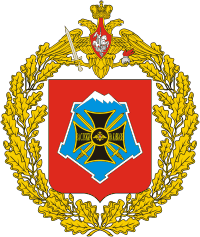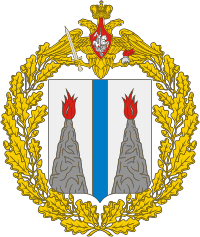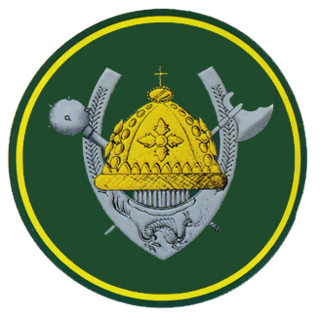
The Western Group of Forces (WGF), previously known as the Group of Soviet Occupation Forces in Germany (GSOFG) and the Group of Soviet Forces in Germany (GSFG), were the troops of the Soviet Army in East Germany. The Group of Soviet Occupation Forces in Germany was formed after the end of World War II in Europe from units of the 1st and 2nd Belorussian Fronts. The group helped suppress the East German uprising of 1953. After the end of occupation functions in 1954 the group was renamed the Group of Soviet Forces in Germany. The group represented Soviet interests in East Germany during the Cold War. After changes in Soviet foreign policy during the late 1980s, the group shifted to a more defensive role and in 1988 became the Western Group of Forces. Russian forces remained in the eastern part of Germany after the dissolution of the Soviet Union and German reunification until 1994.
The Far Eastern Front was a front — a level of military formation that is equivalent to army group — of the Soviet Army during the Russian Civil War and the Second World War.
A mechanised corps was a Soviet armoured formation used prior to the beginning of World War II and reintroduced during the war, in 1942.

The Baltic Military District was a military district of the Soviet armed forces in the Baltic states, formed briefly before the German invasion during the World War II. After end of the war the Kaliningrad Oblast was added to the District's control in 1946, and the territory of Estonia was transferred back to the Baltic Military District from the Leningrad Military District in 1956. The Baltic Military District was disbanded after the fall of the Soviet Union in 1991 and reorganised into the North Western Group of Forces, which ended its existence after withdrawal of all Russian troops from Estonia, Latvia and Lithuania on 1 September 1994.

The North Caucasus Military District was a military district of the Russian Armed Forces, which became in 2010 the Southern Military District and lately also included the Black Sea Fleet and Caspian Flotilla.

The Carpathian Military District was a military district of the Soviet Armed Forces during the Cold War and subsequently of the Armed Forces of Ukraine during the early Post-Soviet period.

The Far Eastern Military District was a military district of the Armed Forces of the Russian Federation. In 2010 it was merged with the Pacific Fleet and part of the Siberian Military District to form the new Eastern Military District.

The Central Group of Forces was a formation of the Soviet Armed Forces used to incorporate Soviet troops in Central Europe on two occasions: in Austria and Hungary from 1945 to 1955 and troops stationed in Czechoslovakia after the Prague Spring of 1968.

The 35th Combined Arms Red Banner Army is a field army of the Russian Ground Forces. The army was first formed in July 1941 with the Far Eastern Front. After spending most of World War II guarding the border in Primorsky Krai, the army fought in the Soviet invasion of Manchuria in August 1945, and was disbanded shortly after the end of the war. Reformed at Belogorsk when Sino-Soviet tensions rose in the late 1960s in the Far East, the army became part of the Eastern Military District in 2010.
A rifle corps was a Soviet corps-level military formation during the mid-twentieth century. Rifle corps were made up of a varying number of rifle divisions, although the allocation of three rifle divisions to a rifle corps was common during the latter part of World War II.

The Transbaikal Military District was a military district of first the Soviet Armed Forces and then the Armed Forces of the Russian Federation, formed on May 17, 1935 and included the Buryat Republic, Chita Oblast, and Yakutia. Chita was the headquarters of the district. It was finally disbanded on December 1, 1998 by being amalgamated with the Siberian Military District, though Chita remained the headquarters of the new amalgamated district.
The 25th Army was a Red Army field army of World War II that served in the Russian Far East.

The 36th Army was a military formation of the Red Army and the Soviet Ground Forces, formed twice.
The 23rd Guards Motor Rifle Division of the Soviet Union's Red Army was a motor rifle division active during the Cold War. After 1991-92, the division's remnants were eventually incorporated into the new Army of Azerbaijan.
The 29th Rifle Division was an infantry division of the Red Army and later the Soviet Army.
The 40th Rifle Division was an infantry division of the Red Army during World War II. It gained the honorific "named for Sergo Ordzhonikidze" on 14 April 1937. It fought in the engagements at Lake Khasan. On 22 June 1941, it was part of the 39th Rifle Corps, 25th Army, in the Far East Military District. The division fought in the Soviet invasion of Manchuria in 1945. In 1957, it was converted into a motorized rifle division. From 1957 to 1989 it was based at Smolyaninovo-1, Primorskiy Krai. In 1989 it was transferred to the Pacific Fleet as a coastal defence division. It was disbanded in 1996.
The 17th Rifle Corps was a corps of the Red Army and later the Soviet Army, formed three times.
The 47th Guards Tank Division was a tank division of the Soviet Army during the Cold War that became part of the Russian Ground Forces after the dissolution of the Soviet Union.









